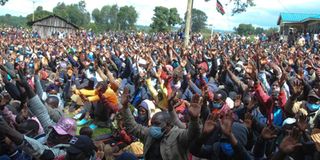Kenya's minority groups struggle 57 years after independence

Members of the Kipsigis and Ogiek communities following proceedings during a peace meeting at Nessuit grounds in Njoro Sub-County on August 4, 2020.
What you need to know:
- The report identifies challenges including law and policy gaps, inadequate resources, insecure land tenure, insecurity, poor infrastructure, poverty, early marriage, the covid-19 pandemic and negative attitudes.
- It also notes that despite the government’s lowering of entry points to tertiary institutions and universities in their areas, the state of education is still critical.
Minority groups such as the Ogiek, Sengwer, Endorois and Awer are still lagging behind in access to education and health services, 57 years after independence, a new report says.
The report also identifies factors such as law and policy gaps, inadequate resources, insecure land tenure, insecurity, poor infrastructure, poverty, early marriage, the Covid-19 pandemic and negative attitudes as some of the challenges the communities face.
It adds that their territories lack piped water yet they are water catchment areas that supply the commodity to many of Kenya’s cities and says access to electricity remains a mirage because of land tenure issues.
“They are also under regular attacks from neighbouring communities and face climate shocks in the form of heavy rains and droughts.”
Consequently, the people’s livelihood systems are constantly interrupted, denying them the chance to live normal lives.
“With no livestock, farms or other income-generating opportunities, they are the poor of the poorest,” the report says, adding that poverty has negated the ability to participate in the economic, social and political life of Kenya as a whole.
Laws needed
In an interview with the Nation, Ogiek People's Development Programme (OPDP) Executive Director Daniel Kobei noted the need for the national and county governments to enact laws for recognition, protection and fulfilment of the rights of indigenous communities within their jurisdictions.
“The county development index health indicators should be broadened to include overall access to health irrespective of the population of different communities,” Mr Kobei said, adding that a partnership with the National Gender and Equality Commission will help develop more detailed disaggregated data on each of the communities under study.
Community consultant Kanyinke Sena said there is also the need for capacity building for activists and government officials on Sustainable Development Goals as well as existing laws and policies for better inclusion of minority groups in county development plans.
“The situation on the ground calls for improved sensitisation on government programmes and policies such as the 30 per cent procurement reservations for women, youth and persons with disabilities.”
The report describes minority groups such as the Ogiek as indigenous communities of forest dwelling hunter-gatherers that inhabit different forest areas in Kenya, with the largest concentration scattered across the seven blocks of the Mau forest complex.
The areas in question are South West Mau, East Mau, Transmara, Mau Narok, Maasai Mau, Western Mau and Southern Mau.
Injustices
The Ogiek’s estimated population is 52,000 and since the colonial times, they have experienced systemic injustices as upheld by the African Court on Human and People's Rights in a landmark ruling on May 26, 2017.
The Sengwer community is largely in Cherengany forests around Talau in West Pokot County, Kapolet in Trans Nzoia and Embobut in Elgeyo Marakwet.
The Endorois inhabit Lake Bogoria and Mochongoi forest areas in Baringo County but in 1974, they were evicted from Lake Bogoria for establishment of the Lake Bogoria Game Reserve.
The Endorois successfully contested the decision to evict them from their land at the African Commission on Human and People's Rights.
Learning institutions
The report also notes that despite the government’s lowering of entry points to tertiary institutions and universities in their areas, the state of education is still critical.
It shows that territories are hardship areas so employees from other communities do not want to work there, leading to high turnover rates. Another hindrance is lack of staff housing and other amenities.
For quality education to be established, recommendations suggest an increase in the number of Early Childhood Development Education (ECDE) centres, as well as provision of at least one secondary school in Chepkitale and Mangai for the Mt Elgon Ogiek and Awer communities respectively.
Another recommendation is for boarding schools to be built to care for people who move from place to place as well as an increase in the ratio of teachers to pupils while ensuring adequate supply of books and laptops.
The report says teachers should also be trained on the use of government-supplied tablet computers.
It further notes the need to construct at least one technical college or polytechnic in Chepkitale, Embobut, Laboi, Mangai and Mariashoni.





